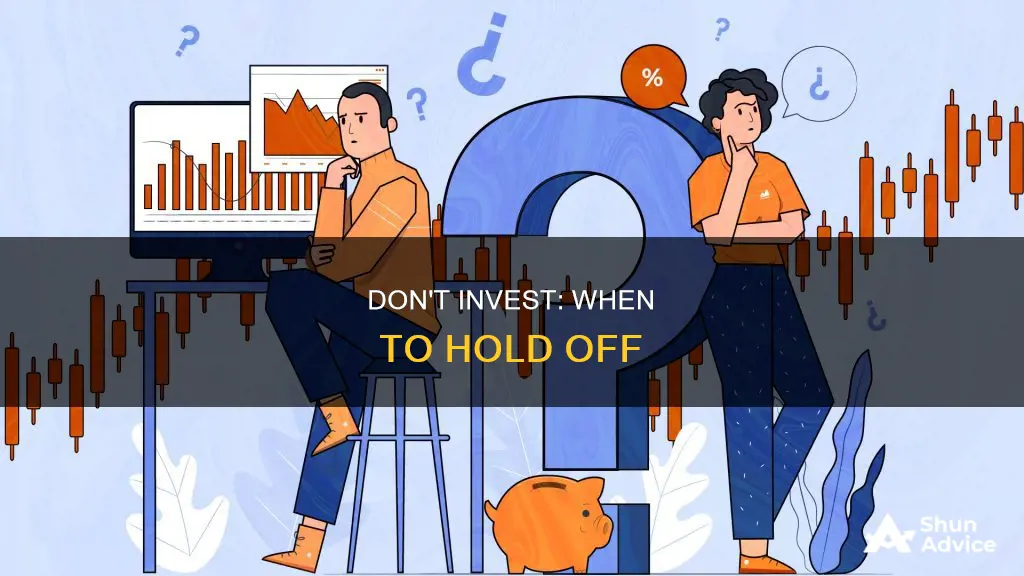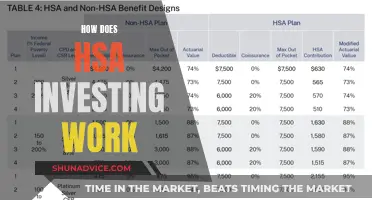
Should I Not Invest Right Now?
Investing can be daunting, especially during periods of volatility. While there is no one-size-fits-all answer to this question, it is generally agreed that having a long-term outlook is essential.
Volatility and Long-Term Outlook
Volatility can be challenging to navigate, but keeping a long-term perspective is crucial. The stock market has consistently earned positive total returns over decades, so staying invested for the long haul is often the best strategy.
Timing the Market
Trying to time the market is generally not recommended, as it can lead to missed opportunities. Instead, focus on finding undervalued stocks or funds that align with your investment goals and risk tolerance.
Diversification and Risk Management
To manage risk, consider diversifying your portfolio across different asset classes, such as stocks, bonds, mutual funds, or exchange-traded funds (ETFs). Diversification can help reduce the impact of market downturns and increase your potential for long-term gains.
Short-Term vs. Long-Term Goals
It is important to distinguish between short-term and long-term financial goals when deciding whether to invest. If you need the money within the next few years, investing in volatile assets may not be suitable.
Dollar-Cost Averaging
Consider using dollar-cost averaging, where you invest a fixed amount at regular intervals instead of trying to time the market. This strategy can help you build a well-diversified portfolio over time without the stress of timing the market.
In conclusion, while there may be short-term fluctuations in the market, investing for the long term can be beneficial. It is important to have a well-diversified portfolio, manage your risk, and focus on your investment goals rather than trying to time the market.
| Characteristics | Values |
|---|---|
| Should I invest right now? | It depends on your goals and risk tolerance. If you are investing for the long term (5+ years), it is generally recommended to invest now rather than trying to time the market. |
| Where to invest? | Options include high-yield savings accounts, certificates of deposit (CDs), bonds, mutual funds, index funds, exchange-traded funds (ETFs), dividend stocks, and individual stocks. |
| How much to invest? | It is recommended to keep 3-6 months' worth of living expenses in a high-yield savings account before investing in riskier assets. |
| How often to invest? | Consistency is key. Consider investing at regular intervals (e.g. dollar-cost averaging) rather than trying to time the market. |
What You'll Learn

You don't have enough emergency savings
If you don't have enough emergency savings, it's best to hold off on investing for now. It's recommended that you have enough savings to cover three to six months' worth of living expenses before you start investing. This will ensure that you have a financial buffer in case of unexpected costs, such as medical bills, car repairs, or a loss of income.
Building an emergency fund is crucial for financial stability and peace of mind. It can help you avoid high-interest debt and provide security during times of financial uncertainty.
- Make a budget: Understanding your income and expenses is essential for finding ways to save. Create a budget to help you allocate your money efficiently and identify areas where you can cut back.
- Set a savings goal: Determine how much you want to save by calculating your total monthly costs and then multiplying that by the number of months' worth of expenses you want to cover.
- Automate your savings: Set up direct deposits or automatic transfers from your paycheck into your savings account. This will help you save consistently without having to remember to transfer funds manually.
- Gradually increase your savings: Start with small savings goals and gradually increase the amount you contribute to your emergency fund over time. Even saving a small amount each month can add up over time.
- Save unexpected income: If you receive a financial windfall, such as a tax refund or bonus, allocate a portion of it to your emergency fund.
- Keep saving: Even after reaching your initial savings goal, continue to save. The more you can add to your emergency fund, the better prepared you'll be for unexpected expenses.
Remember, investing in the stock market or other financial instruments carries risk, and it's important to have a solid financial foundation before taking on that risk. By building a sufficient emergency fund, you'll be better positioned to invest with greater confidence and a longer-term outlook.
Wellness Warriors: Who Invests in Health?
You may want to see also

You're intimidated by investing
Investing can feel intimidating if you see it as only for people with a lot of money or those with expert knowledge. However, it is important to remember that you don't need a large sum of money to start investing.
- Familiarise yourself with common investment terminology: Learning some basic investment terms can help you feel more confident about investing.
- Consider opening an investment account: Look into accounts like a Registered Retirement Savings Plan (RRSP) or a Tax-Free Savings Account (TFSA). These can help you get started with investing without needing a large amount of capital.
- Seek professional advice: A registered investment advisor can guide you through your options and create a plan tailored to your goals and risk tolerance. Having expert advice can help build your confidence and knowledge.
- Do your research: If you're feeling pressured to invest by friends or family, take your time to research the opportunity. Remember, you should never feel pressured to invest.
- Focus on your financial situation: Evaluate your current financial situation, including your income, expenses, and debt. This can help you determine if investing is the right option for you at this time.
- Start with small amounts: If you're just starting out, consider investing small amounts through dollar-cost averaging. This can help reduce the risk and fear of investing all at once.
- Diversify your investments: Don't put all your eggs in one basket. Diversifying your investments across different asset classes and within them can help reduce volatility and protect your portfolio.
Starbucks: Worth Your Investment?
You may want to see also

You're waiting for a higher salary
If you're waiting for a higher salary before you start investing, there are a few things to consider. Firstly, it's important to remember that trying to time the market is often unsuccessful. The best way to build wealth is to stay invested for the long term. Waiting for a higher salary means you miss out on potential investment opportunities and the benefits of compound interest over time.
However, if you're waiting for a higher salary to feel more financially secure before investing, there are a few strategies you can employ. Firstly, focus on increasing your income. This could involve asking for a raise, negotiating your salary, or taking on additional responsibilities at work. You can also develop new skills or certifications that make you more valuable to your company and increase your earning potential.
Once you have a higher salary, it's important to research industry salary trends and evaluate your own financial situation to determine how much you can comfortably invest. Consider factors such as your geographic location, years of experience, education level, career level, and skills when negotiating your salary. Online tools and salary websites can help you understand the market rate for your position.
When investing, it's crucial to make decisions based on long-term expectations rather than short-term market moves. Diversification is also key to reducing risk and protecting your assets. Consider investing across different asset classes, such as stocks, bonds, and international stocks.
Remember, investing is about "time in the market, not timing the market." Don't let a fear of market timing prevent you from starting your investment journey. With a long-term mindset, you can successfully invest in any market condition.
Forging Checks: A Risky Investment Gamble
You may want to see also

You don't understand the risks
When it comes to investing, there are many risks that you should be aware of. Here are some key points to consider:
- Risk of Loss: All investments carry some degree of risk, and you may lose some or all of your original investment. This is the most basic definition of risk in financial terms.
- Market Risk: The possibility of losing money due to economic developments or events that affect the entire market. This includes equity risk, interest rate risk, and currency risk.
- Business Risk: The risk of losing money due to corporate decisions or events specific to a company or industry. This could include expansion plans, mergers, changes in management, product recalls, regulatory changes, or new competition.
- Political and Country Risk: Events within a country, such as political instability or changes in government, can impact your investments, especially in emerging markets.
- Liquidity Risk: This refers to how easy or difficult it is to convert your investment into cash. Some investments may be harder to sell or may require accepting a lower price.
- Concentration Risk: Putting all your money into a single investment or type of investment increases your risk. Diversifying your investments across different types, industries, and geographic locations can help spread this risk.
- Reinvestment Risk: This is the risk of losing money when reinvesting principal or income at a lower interest rate. It applies when interest rates drop or when a bond matures, and you have to reinvest at a lower rate.
- Inflation Risk: Inflation erodes the purchasing power of money over time. Cash and debt investments like bonds are particularly vulnerable, while shares and real estate can offer some protection as prices and rents can be increased.
- Time Horizon Risk: Unforeseen events, such as job loss or medical expenses, may force you to sell your investments earlier than planned, potentially resulting in losses.
- Longevity Risk: This is the risk of outliving your savings, especially relevant for retirees or those nearing retirement.
- Foreign Investment Risk: Investing in foreign countries carries additional risks, such as nationalization or changes in exchange rates, which can impact the value of your investments.
It's important to understand these risks and assess your own risk tolerance before investing. Diversification and asset allocation are essential strategies for managing risk. While investing does carry risks, it's also important to remember that staying out of the market completely may result in missed opportunities for growth.
Fidelity's Investor Numbers
You may want to see also

You don't have clear answers about the investment
If you don't have clear answers about the investment, it's important to remember that you shouldn't invest in anything you don't fully understand. High-risk, high-return investments can be tempting, but they are only suitable for investors who understand and are willing to take on all the risks involved.
Risk Assessment
It's crucial to evaluate your comfort level with risk. All investments carry some degree of risk, and the potential for higher returns is usually accompanied by a higher risk of losing money. Ask yourself if you're prepared to lose some or all of your investment if things go wrong.
Understanding the Investment
Make sure you thoroughly understand the investment opportunity. What is it? How does it work? Who is behind it? Can you easily withdraw your money if needed? It's also important to consider the liquidity of the investment. Can you sell your investment at any time, or are there limited options for doing so?
Regulation and Protection
Check if the investment is regulated and what protections are available if the investment provider or adviser goes out of business. In some cases, high-risk investments may not offer simple answers to these questions.
Financial Advice
Consider seeking financial advice if you need help understanding the investment, its risks, and opportunities. A qualified adviser can assist in creating a plan to achieve your investment goals and recommend a suitable mix of investments based on your circumstances and risk tolerance.
Diversification
Diversifying your investments can help reduce risk. Instead of putting all your eggs in one basket, spread your investments across different asset classes, such as stocks, bonds, and cash. This way, if one investment performs poorly, others may counteract those losses.
Long-Term Perspective
Remember that investing is typically a long-term endeavour. Short-term market fluctuations are common, but over the long run, stocks have historically increased in value. Focus on your long-term goals and be prepared to ride out short-term ups and downs in the market.
In conclusion, while investing can be rewarding, it's crucial to make informed decisions based on thorough research and understanding of the opportunities and risks involved. Don't rush into any investment, and always seek advice from qualified professionals if needed.
Fear of Losing Money Keeps People from Investing
You may want to see also
Frequently asked questions
If you are investing for the long term—five, 10, or 40 years from now—it is as good a time as any to buy stocks. Stock values are based on future expected earnings, which tend to rise over the long run.
If you are asking yourself, "Is now a good time to buy a stock?", consider that it's always a good time to invest when you find a security you've determined is undervalued by the market.
There are a number of investment platforms where you can get started investing for as little as £1.
Some good investment options for beginners include high-yield savings accounts, certificates of deposit (CDs), government bonds, and money market funds.
Look for companies with solid underlying business fundamentals, including strong financials, a competent leadership team, and a competitive advantage in the industry.







